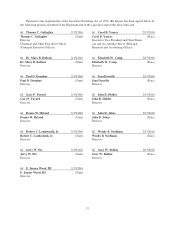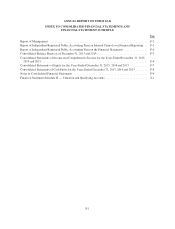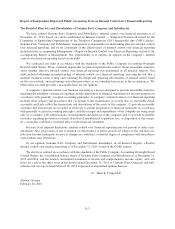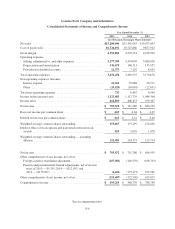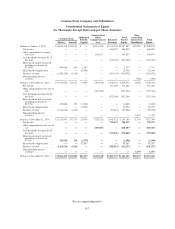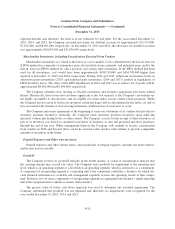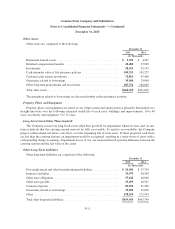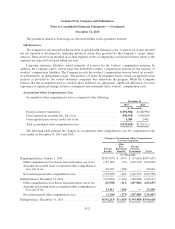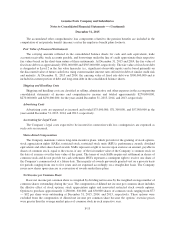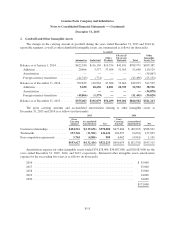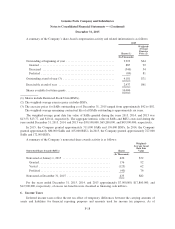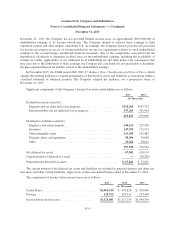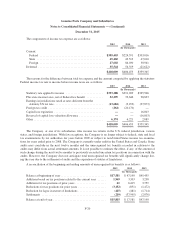Napa Auto Parts 2015 Annual Report Download - page 53
Download and view the complete annual report
Please find page 53 of the 2015 Napa Auto Parts annual report below. You can navigate through the pages in the report by either clicking on the pages listed below, or by using the keyword search tool below to find specific information within the annual report.Genuine Parts Company and Subsidiaries
Notes to Consolidated Financial Statements — (Continued)
December 31, 2015
expected defaults and, therefore, the need to revise estimates for bad debts. For the years ended December 31,
2015, 2014, and 2013, the Company recorded provisions for doubtful accounts of approximately $12,373,000,
$7,192,000, and $8,691,000, respectively. At December 31, 2015 and 2014, the allowance for doubtful accounts
was approximately $10,693,000 and $11,836,000, respectively.
Merchandise Inventories, Including Consideration Received From Vendors
Merchandise inventories are valued at the lower of cost or market. Cost is determined by the last-in, first-out
(LIFO) method for a majority of automotive parts, electrical/electronic materials, and industrial parts, and by the
first-in, first-out (FIFO) method for office products and certain other inventories. If the FIFO method had been
used for all inventories, cost would have been approximately $438,510,000 and $434,790,000 higher than
reported at December 31, 2015 and 2014, respectively. During 2014 and 2013, reductions in inventory levels in
automotive parts inventories (2013) and industrial parts inventories (2014 and 2013) resulted in liquidations of
LIFO inventory layers. The effect of the LIFO liquidations in 2014 and 2013 was to reduce cost of goods sold by
approximately $8,000,000 and $5,000,000, respectively.
The Company identifies slow moving or obsolete inventories and estimates appropriate provisions related
thereto. Historically, these losses have not been significant as the vast majority of the Company’s inventories are
not highly susceptible to obsolescence and are eligible for return under various vendor return programs. While
the Company has no reason to believe its inventory return privileges will be discontinued in the future, its risk of
loss associated with obsolete or slow moving inventories would increase if such were to occur.
The Company enters into agreements at the beginning of each year with many of its vendors that provide for
inventory purchase incentives. Generally, the Company earns inventory purchase incentives upon achieving
specified volume purchasing levels or other criteria. The Company accrues for the receipt of these incentives as
part of its inventory cost based on cumulative purchases of inventory to date and projected inventory purchases
through the end of the year. While management believes the Company will continue to receive consideration
from vendors in 2016 and beyond, there can be no assurance that vendors will continue to provide comparable
amounts of incentives in the future.
Prepaid Expenses and Other Current Assets
Prepaid expenses and other current assets consist primarily of prepaid expenses, amounts due from vendors,
and income taxes receivable.
Goodwill
The Company reviews its goodwill annually in the fourth quarter, or sooner if circumstances indicate that
the carrying amount may exceed fair value. The Company tests goodwill for impairment at the reporting unit
level, which is an operating segment or a level below an operating segment, which is referred to as a component.
A component of an operating segment is a reporting unit if the component constitutes a business for which dis-
crete financial information is available and management regularly reviews the operating results of that compo-
nent. However, two or more components of an operating segment are aggregated and deemed a single reporting
unit if the components have similar economic characteristics.
The present value of future cash flows approach was used to determine any potential impairment. The
Company determined that goodwill was not impaired and, therefore, no impairments were recognized for the
years ended December 31, 2015, 2014, and 2013.
F-10


